
- Subject:
- Applied Science
- Biology
- Life Science
- Material Type:
- Module
- Author:
- OpenStax College
- Date Added:
- 07/18/2021


By the end of this section, you will be able to:Describe the properties of water that are critical to maintaining lifeExplain why water is an excellent solventProvide examples of water’s cohesive and adhesive propertiesDiscuss the role of acids, bases, and buffers in homeostasis

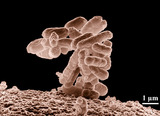
By the end of this section, you will be able to:Identify the shared characteristics of the natural sciencesSummarize the steps of the scientific methodCompare inductive reasoning with deductive reasoningDescribe the goals of basic science and applied science

By the end of this section, you will be able to:Identify and describe the properties of lifeDescribe the levels of organization among living thingsRecognize and interpret a phylogenetic treeList examples of different sub disciplines in biology
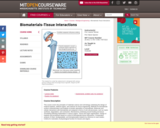
This course covers the principles of materials science and cell biology underlying the design of medical implants, artificial organs, and matrices for tissue engineering. Methods for biomaterials surface characterization and analysis of protein adsorption on biomaterials. Molecular and cellular interactions with biomaterials are analyzed in terms of unit cell processes, such as matrix synthesis, degradation, and contraction. Mechanisms underlying wound healing and tissue remodeling following implantation in various organs. Tissue and organ regeneration. Design of implants and prostheses based on control of biomaterials-tissue interactions. Comparative analysis of intact, biodegradable, and bioreplaceable implants by reference to case studies. Criteria for restoration of physiological function for tissues and organs.
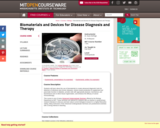
Students will learn about the use of biomaterials to create advanced diagnostic tools for detection of infectious and chronic diseases, restore insulin production to supplement lost pancreatic function in diabetes, provide cells with appropriate physical, mechanical, and biochemical cues to direct tissue regeneration, and enhance the efficacy of cancer immunotherapy.
This course is one of many Advanced Undergraduate Seminars offered by the Biology Department at MIT. These seminars are tailored for students with an interest in using primary research literature to discuss and learn about current biological research in a highly interactive setting. Many instructors of the Advanced Undergraduate Seminars are postdoctoral scientists with a strong interest in teaching.
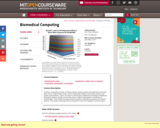
Analyzes computational needs of clinical medicine reviews systems and approaches that have been used to support those needs, and the relationship between clinical data and gene and protein measurements. Topics: the nature of clinical data; architecture and design of healthcare information systems; privacy and security issues; medical expertsystems; introduction to bioinformatics. Case studies and guest lectures describe contemporary systems and research projects. Term project using large clinical and genomic data sets integrates classroom topics.
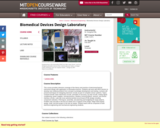
This course provides intensive coverage of the theory and practice of electromechanical instrument design with application to biomedical devices. Students will work with MGH doctors to develop new medical products from concept to prototype development and testing. Lectures will present techniques for designing electronic circuits as part of complete sensor systems. Topics covered include: basic electronics circuits, principles of accuracy, op amp circuits, analog signal conditioning, power supplies, microprocessors, wireless communications, sensors, and sensor interface circuits. Labs will cover practical printed circuit board (PCB) design including component selection, PCB layout, assembly, and planning and budgeting for large projects. Problem sets and labs in the first six weeks are in support of the project. Major team-based design, build, and test project in the last six weeks. Student teams will be composed of both electrical engineering and mechanical engineering students.

Students examine the structure and function of the human eye, learning some amazing features about our eyes, which provide us with sight and an understanding of our surroundings. Students also learn about some common eye problems and the biomedical devices and medical procedures that resolve or help to lessen the effects of these vision deficiencies, including vision correction surgery.
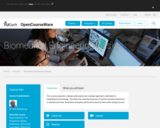
This course presents a design philosophy and a design approach, dedicated to rehabilitation technology. This field was selected because of human-machine interaction is inherent and vital. Illustrative examples will be discussed by their entire design process

Seminars exploring current research and topical issues in the biomedical sciences, addressed at the general theme of innovation. Seminars are organized in blocks with related content, and are presented by prominent outside speakers as well as by HST faculty members and graduate students. Each seminar block includes several semi-weekly presentations, in addition to wide-ranging discussions among speakers, faculty, and students. Discussions involve issues such as relations between presented research areas, requirements for further advances in the "state of the art", the role of enabling technologies, the responsible practice of biomedical research, and career paths in the biomedical sciences. This course consists of a series of seminars focused on the development of professional skills. Each semester focuses on a different topic, resulting in a repeating cycle that covers medical ethics, responsible conduct of research, written and oral technical communication, and translational issues. Material and activities include guest lectures, case studies, interactive small group discussions, and role-playing simulations.
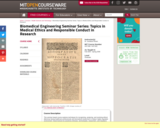
Seminars exploring current research and topical issues in the biomedical sciences, addressed at the general theme of innovation. Seminars are organized in blocks with related content, and are presented by prominent outside speakers as well as by HST faculty members and graduate students. Each seminar block includes several semi-weekly presentations, in addition to wide-ranging discussions among speakers, faculty, and students. Discussions involve issues such as relations between presented research areas, requirements for further advances in the "state of the art", the role of enabling technologies, the responsible practice of biomedical research, and career paths in the biomedical sciences.
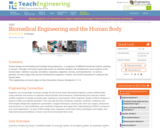
Human beings are fascinating and complex living organisms a symphony of different functional systems working in concert. Through a 10-lesson series with hands-on activities students are introduced to seven systems of the human body skeletal, muscular, circulatory, respiratory, digestive, sensory, and reproductive as well as genetics. At every stage, they are also introduced to engineers' creative, real-world involvement in caring for the human body.
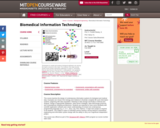
This course teaches the design of contemporary information systems for biological and medical data. Examples are chosen from biology and medicine to illustrate complete life cycle information systems, beginning with data acquisition, following to data storage and finally to retrieval and analysis. Design of appropriate databases, client-server strategies, data interchange protocols, and computational modeling architectures. Students are expected to have some familiarity with scientific application software and a basic understanding of at least one contemporary programming language (e.g. C, C++, Java, Lisp, Perl, Python). A major term project is required of all students. This subject is open to motivated seniors having a strong interest in biomedical engineering and information system design with the ability to carry out a significant independent project. This course was offered as part of the Singapore-MIT Alliance (SMA) program as course number SMA 5304.
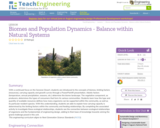
With a continued focus on the Sonoran Desert, students are introduced to the concepts of biomes, limiting factors (resources), carrying capacity and growth curves through a PowerPoint® presentation. Abiotic factors (temperature, annual precipitation, seasons, etc.) determine the biome landscape. The vegetative component, as producers, determines the types of consumers that form its various communities. Students learn how the type and quantity of available resources defines how many organisms can be supported within the community, as well as its particular resident species. Students use mathematical models of natural relationships (in this case, sigmoid and exponential growth curves) to analyze population information and build upon it. With this understanding, students are able to explain how carrying capacity is determined by the limiting factors within the community and feeding relationships. By studying these ecological relationships, students see the connection between ecological relationships of organisms and the fundamentals of engineering design, adding to their base of knowledge towards solving the grand challenge posed in this unit.
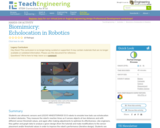
Students use ultrasonic sensors and LEGO© MINDSTORMS© NXT robots to emulate how bats use echolocation to detect obstacles. They measure the robot's reaction times as it senses objects at two distances and with different sensor threshold values, and again after making adjustments to optimize its effectiveness. Like engineers, they gather and graph data to analyze a given design (from the tutorial) and make modifications to the sensor placement and/or threshold values in order to improve the robot's performance (iterative design). Students see how problem solving with biomimicry design is directly related to understanding and making observations of nature.
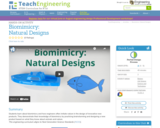
Students learn about biomimicry and how engineers often imitate nature in the design of innovative new products. They demonstrate their knowledge of biomimicry by practicing brainstorming and designing a new product based on what they know about animals and nature.
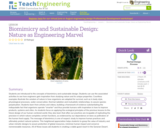
Students are introduced to the concepts of biomimicry and sustainable design. Countless examples illustrate the wisdom of nature in how organisms are adapted for survival, such as in body style, physiological processes, water conservation, thermal radiation and mutualistic relationships, to assure species perpetuation. Students learn from articles and videos, building a framework of evidence substantiating the indisputable fact that organisms operate "smarter" and thus provide humans with inspiration in how to improve products, systems and cities. As students focus on applying the ecological principles of the previous lessons to the future design of our human-centered world, they also learn that often our practices are incapable of replicating the precision in which nature completes certain functions, as evidenced by our dependence on bees as pollinators of the human food supply. The message of biomimicry is one of respect: study to improve human practices and ultimately protect natural systems. This heightened appreciation helps students to grasp the value of industry and urban mimetic designs to assure protection of global resources, minimize human impact and conserve nonrenewable resources. All of these issues aid students in creating a viable guest resort in the Sonoran Desert.
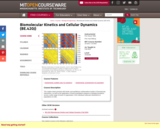
This subject deals primarily with kinetic and equilibrium mathematical models of biomolecular interactions, as well as the application of these quantitative analyses to biological problems across a wide range of levels of organization, from individual molecular interactions to populations of cells.